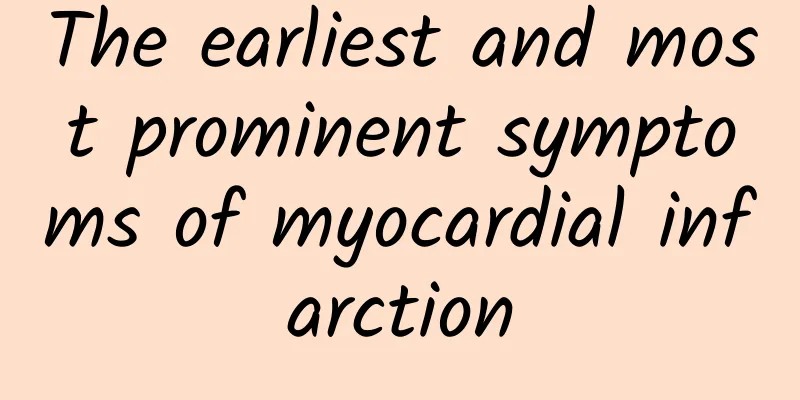The earliest and most prominent symptoms of myocardial infarction

|
Myocardial infarction is a relatively common complication at present. Myocardial infarction can be divided into many types clinically. Generally, after a myocardial infarction occurs, the patient's heart function will be affected, and angina pectoris, transient ischemia and hypoxia will not occur. This is also the earliest and most obvious symptom of myocardial infarction, but some patients may have no symptoms. Myocardial infarction can occur at any time in different stages, so people should pay attention to observe changes in their bodies as they get older. 1. Clinical manifestations: Clinical manifestations are related to the size and location of myocardial infarction, the mechanism of collateral circulation and individual response. 1. Premonitions of myocardial infarction Premonitions of myocardial infarction are defined as the transitional type between angina pectoris and myocardial infarction. Angina pectoris is a clinical symptom caused by acute and temporary myocardial ischemia and hypoxia, and has paroxysmal clinical characteristics. Severe angina pectoris that cannot be confirmed by clinical, electrocardiogram, and serum enzyme tests as acute myocardial infarction is a precursor disease of acute myocardial infarction. The pathological basis of the precursors to myocardial infarction is focal necrosis caused by coronary artery insufficiency. The damage to myocardial cells is slow and scattered in ischemic myocardial dystrophy, and miliary necrosis foci may be seen under the microscope. The angina pectoris of this type of patients lasts for 10 to 15 minutes, and they may suffer myocardial infarction in the short term. Clinically, they are generally divided into three types. 1. Asymptomatic patients have persistent angina pectoris lasting 15 to 30 minutes or longer during rest or at night. Paroxysmal or progressive exacerbations, these patients have no clinical or electrocardiographic manifestations of myocardial infarction (first-onset angina pectoris). 2. For patients with a history of angina pectoris, whose angina attacks are more frequent than in the past and whose attacks last longer, nitroglycerin has a poor effect (exacerbated angina pectoris).
3. After a myocardial infarction (old myocardial infarction), after a pain-free period, angina attacks occur repeatedly during rest. Angina pectoris is accompanied by nausea, vomiting, sweating and tachycardia, or accompanied by heart failure, severe arrhythmia, large fluctuations in blood pressure, etc. At the same time, the electrocardiogram shows that the ST segment is temporarily significantly elevated (variant angina pectoris) or depressed, and the T wave is inverted or increased ("pseudo-normalization"). Premonitions of myocardial infarction are often clinical manifestations before acute myocardial infarction and can serve as a harbinger of acute myocardial infarction, so they should be prevented and treated early. Although angina attacks during quiet bed rest may be temporary and reversible, most of them are precursors to myocardial infarction. It has been reported that 15% to 31% of patients develop acute myocardial infarction within 3 months. Therefore, for patients with exertional angina pectoris, when resting angina pectoris occurs, the precursors to myocardial infarction should be considered and should never be ignored. The patient should be alert to the possibility of myocardial infarction in the near future, receive timely and active treatment, and try to prevent large-area myocardial infarction. The precursor symptoms of myocardial infarction in the elderly are often not obvious. Some people believe that about half of the cases have precursor symptoms within 1 to 2 weeks before myocardial infarction, but most of the symptoms are atypical. It has been reported that among elderly people with myocardial infarction whose infarction area has a diameter greater than 5 cm, 48% have pain symptoms. |
<<: What to do if you have a sudden myocardial infarction
>>: Taboos of pepper foot bath
Recommend
Symptoms of getting angry in spring
Don’t think that getting a sore throat only occur...
Why is there always white discharge in the corners of the eyes?
If there is always white secretion in the corners...
Why do I have breast pain recently?
A woman's breasts continue to grow and develo...
What causes diarrhea after ejaculation?
Diarrhea after ejaculation is not particularly co...
Traditional Chinese Medicine for Tracheitis
As the development of modernization continues to ...
Can I eat crabs after having a medical abortion?
Crab is a common food in our daily life. Many peo...
Why do I feel sore, weak and have diarrhea?
In the hot summer, people with weak constitutions...
What are the effects of Dendrobium officinale flowers
Dendrobium officinale is a relatively important C...
How are pelvic floor disorders treated?
The pelvic floor is what people call the bottom of...
What are the Chinese herbal foot baths?
The weather is getting colder day by day, and som...
Why are your feet cold in hot weather?
Compared with men, women's bodies are more su...
I have a hard pimple.
Acne seems to be a problem that every friend will...
4 most cost-effective folk remedies for treating chronic pharyngitis
The autumn weather is actually the onset period o...
What is the best way to drink saffron?
Rose tea has many wonderful effects. It can be us...
Causes of damp-heat in the spleen and stomach
Nowadays, many people have improper diet. Heavy l...









